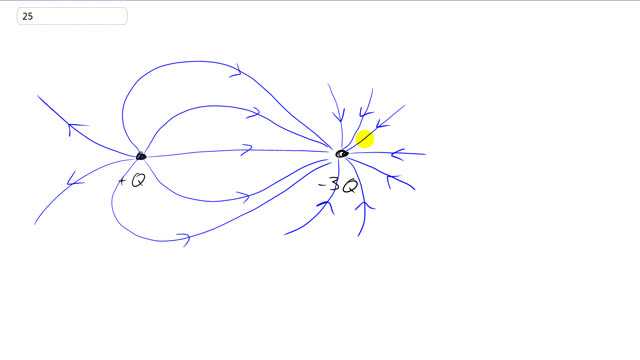
Draw, approximately, the electric field lines about two point charges, +Q and -3Q, which are a distance apart.

In order to watch this solution you need to have a subscription.
This is Giancoli Answers with Mr. Dychko. Here are the electric field lines around two point charges. One with a charge plus Q and the other with a charge of negative three Q. And the way you figure out how the field length should look is consider a positive test charge at any point here and what would happen to it. So if you had a positive test charge placed here, it would be attracted to this right-hand charge and it would be somewhat repelled by this charge here. But it's so much closer to the negative three Q charged that this force is gonna predominate. This attracted force here will predominate over the repulsive force that it experiences this way to the bad charge. Furthermore, this charge is of greater magnitude. That's another reason why this force would predominate. So it's gonna, in the end, be attracted to this point here. Now, if you put a point to a charge here, it will be both attracted over here and it will be repelled by this force or by this charge here. And the vertical components looks like it might cancel out with a net field or a net force on this charge being in this direction. So the direction of the field is this tangent to this field lines here. Here's the net result there. A point here, a test charge there, it'll experience attraction to this one, sure, but it's so much closer to this positive test charge that the repulsion from that one would predominate and so it's just gonna go like that approximately the same as if this thing didn't even exist. It would go radially outwards from this positive charge here because it's so close to it. Since electric field, it varies as one over the distance squared. This distance makes a big difference. So when it's really close to this charge, that means that the large distance from this charge is gonna make that electric field due to this charge so much smaller because it's gonna be divided by that distance squared. And so on, and so on, and so on, you put positive test charges where it'd be like and then imagine what the direction of the force would be on it, and then that's the direction of the electric field there.
Should there be 3x's as many field lines going into the -3Q charge compared to the +1Q charge?
Hi williams.dpw, thanks for the question. Yes, I suppose that's an interesting point to consider, although things are not quite as simple as they might seem. Taking the two points in isolation (considering a case that is simple first), it's true that which means the field strength is directly proportional to the charge. This means that a point with three times the charge of another point will have an electric field strength 3 times as strong, and yes, in that case the number of field lines should be three times as well. When the two charges are near each other, as in this question, and their fields are interacting, then this interaction changes the number of field lines you would expect compared to the case when they're in isolation. Nevertheless I would agree that the picture could use more field lines going into the charge. When considering a position very close to a point charge, the effect of the other point charge becomes negligible since their field strengths are inversely proportional to distance from the point charge. What this means is that, close to one point charge, the other point charge doesn't matter, and if you zoom in on any point charge it will be possible to find a "zoom level" at which the field lines look the same as a point charge in isolation.
I suppose I'm arguing both for and against your excellent point. The only way to get a quantitatively correct picture is to use a computer to create the vector field by calculating the resultant electric field (which is not a trivial calculation since these fields add as vectors) at every point. The hand drawn picture is meant just to show an approximation. I think an important feature of the drawing is to show the field emanating left of the left point charge bending around to the right hand charge, which would happen only if the right hand charge has a greater magnitude of charge. Also, yes, I would agree for the most part that the density of field lines around the right hand charge should be nearly 3 times that of the left hand charge, but not exactly so since the left hand charge reduces the field strength around the right hand charge.
Hope that helps!
Mr. Dychko